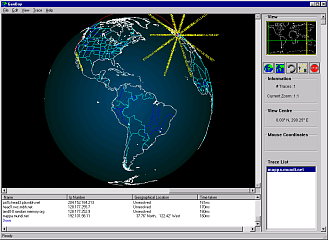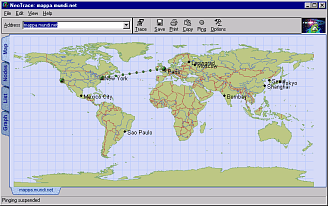
Add a Bit of Geography
An obvious refinement of the vanilla traceroute is to show how the data flows on a world map. This is known as a geographical traceroute and there are three commercially available applications [3] - GeoBoy, NeoTrace
and VisualRoute.
These are all easy to use, affordable applications (available only for Windows) which attempt, with varying degrees of success, to map the physical location of Internet nodes traversed in a trace. In a mini "bake-off" I used them to run the above trace from London to Mappa.Mundi.
GeoBoy
GeoBoy is produced by NDG Software as part of a suite of real-time, visual network management tools. It has been around for a few years, coming from a research prototype developed at Curtin University of Technology in Australia. It has the facility to map traces on a flat world map and also a pseudo 3d globe. Unfortunately, GeoBoy did not do too well mapping our trace, only locating the first node correctly in London. It was not able locate any further nodes and I had to manually tell it that Mappa.Mundi was in Silicon Valley. GeoBoy is beginning to show its age in terms of speed and functionality, but there are rumours of a major overhaul in the pipeline as GeoBoy2.

Screenshot of GeoBoy
click on image for larger view |
NeoTrace
NeoTrace is the newest geographical traceroute, being developed by NeoWorx from a graphical layout into a fully fledged geographical tool. NeoTrace provides four different views of the trace in tabbed panels - a geographic map, a nodal graph layout, a conventional listing and a line graph of performance. The figure shows the map view of our trace and it has done a good job, successfully locating seven nodes including the target in Redwood City, CA.

Screenshot of NeoTrace
click on image for larger view |
VisualRoute
The last application in the "bake-off" is VisualRoute from Datametrics Systems Corporation. The application interface provides both a map and listing of the trace. In our trace to Mappa.Mundi it found the location of six nodes with confidence and made educated guesses at a further seven. Unfortunately, the guess of the final node was erroneous and therefore put Mappa.Mundi in Washington DC.

Screenshot of VisualRoute
click on image for larger view |
Although geographical traceroutes are useful developments, their mapping capabilities are limited at present because of the serious difficulties in mapping an Internet node (logically identified by a network address) to an actual latitude and longitude on the globe. There is no automatic means to achieve this mapping of virtual to real-world addresses. Consequently, these programs use a variety of heuristics to try and resolve a network node to a geographic location with differing levels of accuracy [4]. This is a difficult problem to crack and as we saw they have varying degrees of success in doing it. In the end, they are largely dependent on looking up the Internet addresses in static databases of latitude and longitude, but these are partial and can not keep pace with dynamic growth and change of the global Internet. A more effective solution is the addition of geographic location information to the domain names, as set out in DNS-LOC [5], which can be dynamically queried. However this scheme has, unfortunately, not been widely implemented.
Conclusions
Why is traceroute useful? Firstly, traceroute is an important Internet debugging tool for those involved in keeping networks running. It can help identify routing problems quickly and simply. It can be useful for tracking down the source of spam [6] and also finding out where a web site is located before you give them your credit card details.
On another level, traceroute can help to satisfy people's curiosity to know how their computer connects to the global Internet and how they can access information from all around the world as if it were just next door. Traceroute reveals the hidden complexity of data flows, traversing ten, twenty or more nodes, usually owned and operated by competing companies, to reach a given destination. Being able to look at what's happening in real-time in the Internet always gives me a small sense of wonder that this system works so well, enabling tens of millions of people to communicate daily. So if you have a little time, go and trace the route to your favourite web site and uncover the hidden complexity of the Internet that lies beyond the browser window. You may be surprised how the data flows.
Copyright © 1999, 2000 media.org.
|